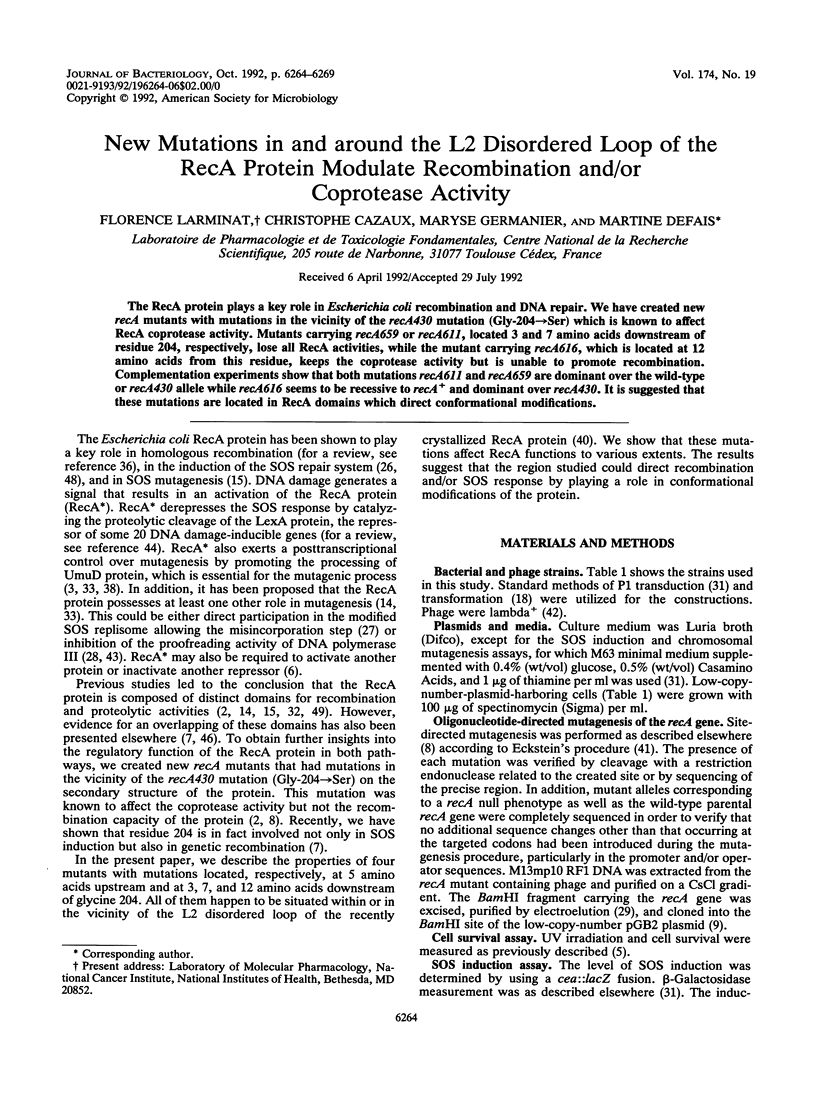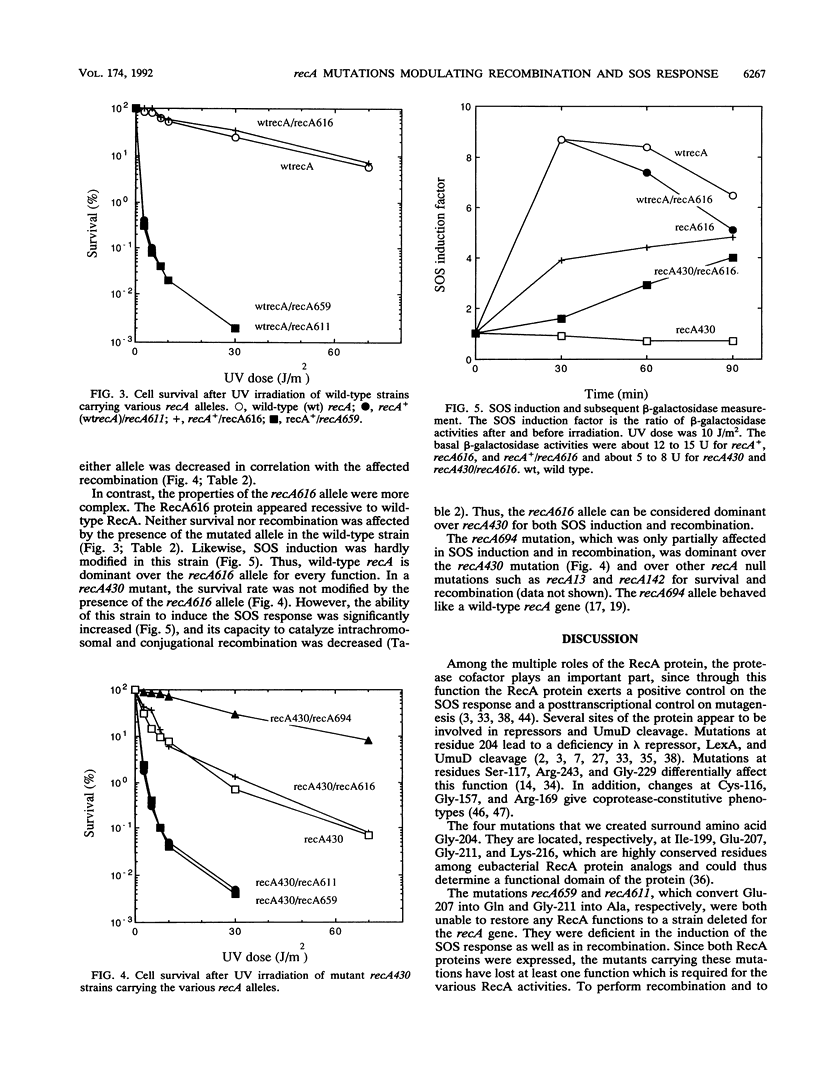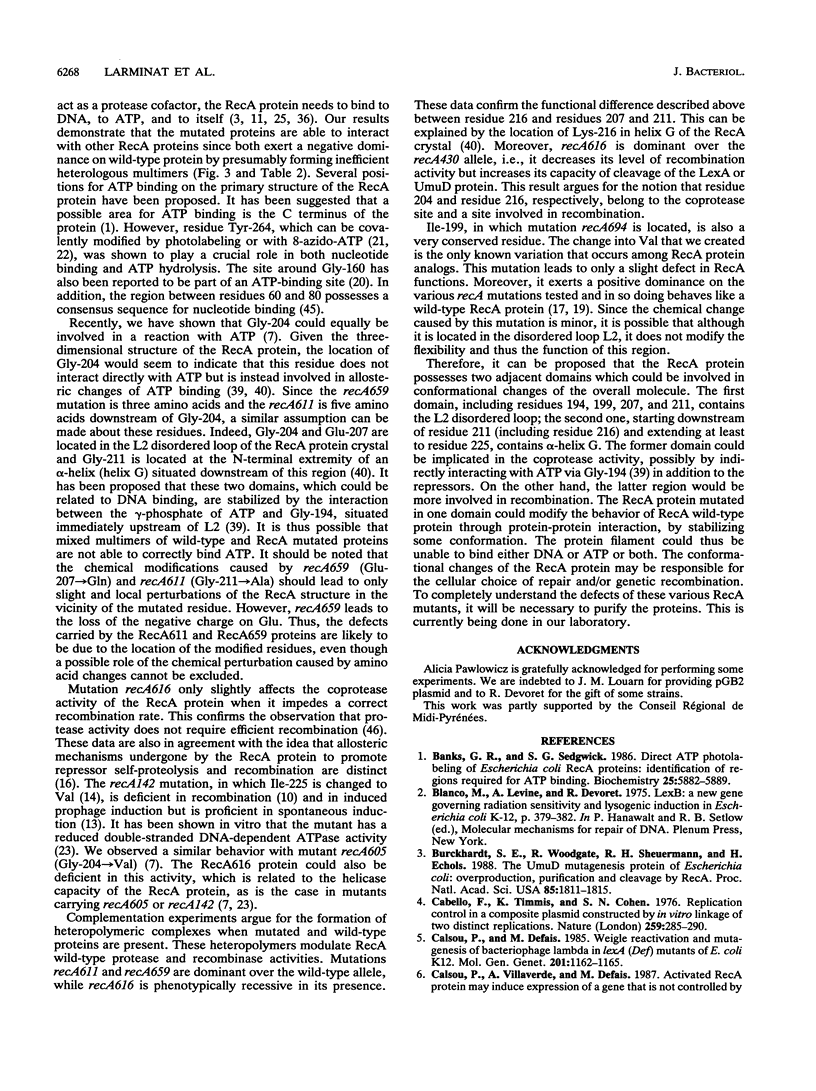Abstract
The RecA protein plays a key role in Escherichia coli recombination and DNA repair. We have created new recA mutants with mutations in the vicinity of the recA430 mutation (Gly-204----Ser) which is known to affect RecA coprotease activity. Mutants carrying recA659 or recA611, located 3 and 7 amino acids downstream of residue 204, respectively, lose all RecA activities, while the mutant carrying recA616, which is located at 12 amino acids from this residue, keeps the coprotease activity but is unable to promote recombination. Complementation experiments show that both mutations recA611 and recA659 are dominant over the wild-type or recA430 allele while recA616 seems to be recessive to recA+ and dominant over recA430. It is suggested that these mutations are located in RecA domains which direct conformational modifications.
Full text
PDF





Selected References
These references are in PubMed. This may not be the complete list of references from this article.
- Banks G. R., Sedgwick S. G. Direct ATP photolabeling of Escherichia coli recA proteins: identification of regions required for ATP binding. Biochemistry. 1986 Oct 7;25(20):5882–5889. doi: 10.1021/bi00368a007. [DOI] [PubMed] [Google Scholar]
- Blanco M., Levine A., Devoret R. IexB: a new gene governing radiation sensitivity and lysogenic induction in Escherichia coli K12. Basic Life Sci. 1975;5A:379–382. doi: 10.1007/978-1-4684-2895-7_50. [DOI] [PubMed] [Google Scholar]
- Burckhardt S. E., Woodgate R., Scheuermann R. H., Echols H. UmuD mutagenesis protein of Escherichia coli: overproduction, purification, and cleavage by RecA. Proc Natl Acad Sci U S A. 1988 Mar;85(6):1811–1815. doi: 10.1073/pnas.85.6.1811. [DOI] [PMC free article] [PubMed] [Google Scholar]
- Cabello F., Timmis K., Cohen S. N. Replication control in a composite plasmid constructed by in vitro linkage of two distinct replicons. Nature. 1976 Jan 29;259(5541):285–290. doi: 10.1038/259285a0. [DOI] [PubMed] [Google Scholar]
- Calsou P., Villaverde A., Defais M. Activated RecA protein may induce expression of a gene that is not controlled by the LexA repressor and whose function is required for mutagenesis and repair of UV-irradiated bacteriophage lambda. J Bacteriol. 1987 Oct;169(10):4816–4821. doi: 10.1128/jb.169.10.4816-4821.1987. [DOI] [PMC free article] [PubMed] [Google Scholar]
- Cazaux C., Defais M. Genetical and biochemical evidence for the involvement of the coprotease domain of Escherichia coli RecA protein in recombination. J Mol Biol. 1992 Feb 20;223(4):823–829. doi: 10.1016/0022-2836(92)90243-d. [DOI] [PubMed] [Google Scholar]
- Cazaux C., Larminat F., Defais M. Site-directed mutagenesis in the Escherichia coli recA gene. Biochimie. 1991 Feb-Mar;73(2-3):281–284. doi: 10.1016/0300-9084(91)90214-l. [DOI] [PubMed] [Google Scholar]
- Churchward G., Belin D., Nagamine Y. A pSC101-derived plasmid which shows no sequence homology to other commonly used cloning vectors. Gene. 1984 Nov;31(1-3):165–171. doi: 10.1016/0378-1119(84)90207-5. [DOI] [PubMed] [Google Scholar]
- Clark A. J. Recombination deficient mutants of E. coli and other bacteria. Annu Rev Genet. 1973;7:67–86. doi: 10.1146/annurev.ge.07.120173.000435. [DOI] [PubMed] [Google Scholar]
- Craig N. L., Roberts J. W. E. coli recA protein-directed cleavage of phage lambda repressor requires polynucleotide. Nature. 1980 Jan 3;283(5742):26–30. doi: 10.1038/283026a0. [DOI] [PubMed] [Google Scholar]
- Csonka L. N., Clark A. J. Deletions generated by the transposon Tn10 in the srl recA region of the Escherichia coli K-12 chromosome. Genetics. 1979 Oct;93(2):321–343. doi: 10.1093/genetics/93.2.321. [DOI] [PMC free article] [PubMed] [Google Scholar]
- Dutreix M., Bailone A., Devoret R. Efficiency of induction of prophage lambda mutants as a function of recA alleles. J Bacteriol. 1985 Mar;161(3):1080–1085. doi: 10.1128/jb.161.3.1080-1085.1985. [DOI] [PMC free article] [PubMed] [Google Scholar]
- Dutreix M., Moreau P. L., Bailone A., Galibert F., Battista J. R., Walker G. C., Devoret R. New recA mutations that dissociate the various RecA protein activities in Escherichia coli provide evidence for an additional role for RecA protein in UV mutagenesis. J Bacteriol. 1989 May;171(5):2415–2423. doi: 10.1128/jb.171.5.2415-2423.1989. [DOI] [PMC free article] [PubMed] [Google Scholar]
- Ennis D. G., Fisher B., Edmiston S., Mount D. W. Dual role for Escherichia coli RecA protein in SOS mutagenesis. Proc Natl Acad Sci U S A. 1985 May;82(10):3325–3329. doi: 10.1073/pnas.82.10.3325. [DOI] [PMC free article] [PubMed] [Google Scholar]
- Freitag N. E., McEntee K. Site-directed mutagenesis of the RecA protein of Escherichia coli. Tyrosine 264 is required for efficient ATP hydrolysis and strand exchange but not for LexA repressor inactivation. J Biol Chem. 1991 Apr 15;266(11):7058–7066. [PubMed] [Google Scholar]
- George J., Devoret R. Conjugal transfer of UV-damaged F-prime sex factors and indirect induction of prophage- . Mol Gen Genet. 1971;111(2):103–119. doi: 10.1007/BF00267786. [DOI] [PubMed] [Google Scholar]
- Howard-Flanders P., Boyce R. P., Theriot L. Three loci in Escherichia coli K-12 that control the excision of pyrimidine dimers and certain other mutagen products from DNA. Genetics. 1966 Jun;53(6):1119–1136. doi: 10.1093/genetics/53.6.1119. [DOI] [PMC free article] [PubMed] [Google Scholar]
- Kawashima H., Horii T., Ogawa T., Ogawa H. Functional domains of Escherichia coli recA protein deduced from the mutational sites in the gene. Mol Gen Genet. 1984;193(2):288–292. doi: 10.1007/BF00330682. [DOI] [PubMed] [Google Scholar]
- Knight K. L., McEntee K. Covalent modification of the recA protein from Escherichia coli with the photoaffinity label 8-azidoadenosine 5'-triphosphate. J Biol Chem. 1985 Jan 25;260(2):867–872. [PubMed] [Google Scholar]
- Knight K. L., McEntee K. Tyrosine 264 in the recA protein from Escherichia coli is the site of modification by the photoaffinity label 8-azidoadenosine 5'-triphosphate. J Biol Chem. 1985 Aug 25;260(18):10185–10191. [PubMed] [Google Scholar]
- Kowalczykowski S. C., Burk D. L., Krupp R. A. Biochemical events essential to the recombination activity of Escherichia coli RecA protein. I. Properties of the mutant RecA142 protein. J Mol Biol. 1989 Jun 20;207(4):719–733. doi: 10.1016/0022-2836(89)90239-8. [DOI] [PubMed] [Google Scholar]
- Larminat F., Defais M. Modulation of the SOS response by truncated RecA proteins. Mol Gen Genet. 1989 Mar;216(1):106–112. doi: 10.1007/BF00332237. [DOI] [PubMed] [Google Scholar]
- Little J. W., Mount D. W. The SOS regulatory system of Escherichia coli. Cell. 1982 May;29(1):11–22. doi: 10.1016/0092-8674(82)90085-x. [DOI] [PubMed] [Google Scholar]
- Little J. W., Mount D. W., Yanisch-Perron C. R. Purified lexA protein is a repressor of the recA and lexA genes. Proc Natl Acad Sci U S A. 1981 Jul;78(7):4199–4203. doi: 10.1073/pnas.78.7.4199. [DOI] [PMC free article] [PubMed] [Google Scholar]
- Lu C., Echols H. RecA protein and SOS. Correlation of mutagenesis phenotype with binding of mutant RecA proteins to duplex DNA and LexA cleavage. J Mol Biol. 1987 Aug 5;196(3):497–504. doi: 10.1016/0022-2836(87)90027-1. [DOI] [PubMed] [Google Scholar]
- Lu C., Scheuermann R. H., Echols H. Capacity of RecA protein to bind preferentially to UV lesions and inhibit the editing subunit (epsilon) of DNA polymerase III: a possible mechanism for SOS-induced targeted mutagenesis. Proc Natl Acad Sci U S A. 1986 Feb;83(3):619–623. doi: 10.1073/pnas.83.3.619. [DOI] [PMC free article] [PubMed] [Google Scholar]
- Menetski J. P., Kowalczykowski S. C. Biochemical properties of the Escherichia coli recA430 protein. Analysis of a mutation that affects the interaction of the ATP-recA protein complex with single-stranded DNA. J Mol Biol. 1990 Feb 20;211(4):845–855. doi: 10.1016/0022-2836(90)90078-Z. [DOI] [PubMed] [Google Scholar]
- Nohmi T., Battista J. R., Dodson L. A., Walker G. C. RecA-mediated cleavage activates UmuD for mutagenesis: mechanistic relationship between transcriptional derepression and posttranslational activation. Proc Natl Acad Sci U S A. 1988 Mar;85(6):1816–1820. doi: 10.1073/pnas.85.6.1816. [DOI] [PMC free article] [PubMed] [Google Scholar]
- Ogawa H., Ogawa T. General recombination: functions and structure of RecA protein. Adv Biophys. 1986;21:135–148. doi: 10.1016/0065-227x(86)90019-5. [DOI] [PubMed] [Google Scholar]
- Roberts J. W., Roberts C. W. Two mutations that alter the regulatory activity of E. coli recA protein. Nature. 1981 Apr 2;290(5805):422–424. doi: 10.1038/290422a0. [DOI] [PubMed] [Google Scholar]
- Roca A. I., Cox M. M. The RecA protein: structure and function. Crit Rev Biochem Mol Biol. 1990;25(6):415–456. doi: 10.3109/10409239009090617. [DOI] [PubMed] [Google Scholar]
- Salles B., Weinstock G. M. Mutation of the promoter and LexA binding sites of cea, the gene encoding colicin E1. Mol Gen Genet. 1989 Feb;215(3):483–489. doi: 10.1007/BF00427047. [DOI] [PubMed] [Google Scholar]
- Shinagawa H., Iwasaki H., Kato T., Nakata A. RecA protein-dependent cleavage of UmuD protein and SOS mutagenesis. Proc Natl Acad Sci U S A. 1988 Mar;85(6):1806–1810. doi: 10.1073/pnas.85.6.1806. [DOI] [PMC free article] [PubMed] [Google Scholar]
- Story R. M., Steitz T. A. Structure of the recA protein-ADP complex. Nature. 1992 Jan 23;355(6358):374–376. doi: 10.1038/355374a0. [DOI] [PubMed] [Google Scholar]
- Story R. M., Weber I. T., Steitz T. A. The structure of the E. coli recA protein monomer and polymer. Nature. 1992 Jan 23;355(6358):318–325. doi: 10.1038/355318a0. [DOI] [PubMed] [Google Scholar]
- Taylor J. W., Ott J., Eckstein F. The rapid generation of oligonucleotide-directed mutations at high frequency using phosphorothioate-modified DNA. Nucleic Acids Res. 1985 Dec 20;13(24):8765–8785. doi: 10.1093/nar/13.24.8765. [DOI] [PMC free article] [PubMed] [Google Scholar]
- Villani G., Boiteux S., Radman M. Mechanism of ultraviolet-induced mutagenesis: extent and fidelity of in vitro DNA synthesis on irradiated templates. Proc Natl Acad Sci U S A. 1978 Jul;75(7):3037–3041. doi: 10.1073/pnas.75.7.3037. [DOI] [PMC free article] [PubMed] [Google Scholar]
- Walker G. C. Mutagenesis and inducible responses to deoxyribonucleic acid damage in Escherichia coli. Microbiol Rev. 1984 Mar;48(1):60–93. doi: 10.1128/mr.48.1.60-93.1984. [DOI] [PMC free article] [PubMed] [Google Scholar]
- Walker J. E., Saraste M., Runswick M. J., Gay N. J. Distantly related sequences in the alpha- and beta-subunits of ATP synthase, myosin, kinases and other ATP-requiring enzymes and a common nucleotide binding fold. EMBO J. 1982;1(8):945–951. doi: 10.1002/j.1460-2075.1982.tb01276.x. [DOI] [PMC free article] [PubMed] [Google Scholar]
- Wang W. B., Tessman E. S. Location of functional regions of the Escherichia coli RecA protein by DNA sequence analysis of RecA protease-constitutive mutants. J Bacteriol. 1986 Nov;168(2):901–910. doi: 10.1128/jb.168.2.901-910.1986. [DOI] [PMC free article] [PubMed] [Google Scholar]
- Weisemann J. M., Weinstock G. M. Mutations at the cysteine codons of the recA gene of Escherichia coli. DNA. 1988 Jul-Aug;7(6):389–398. doi: 10.1089/dna.1.1988.7.389. [DOI] [PubMed] [Google Scholar]
- Witkin E. M. Ultraviolet mutagenesis and inducible DNA repair in Escherichia coli. Bacteriol Rev. 1976 Dec;40(4):869–907. doi: 10.1128/br.40.4.869-907.1976. [DOI] [PMC free article] [PubMed] [Google Scholar]
- Yarranton G. T., Sedgwick S. G. Cloned truncated recA genes in E. coli II. Effects of truncated gene products on in vivo recA+ protein activity. Mol Gen Genet. 1982;185(1):99–104. doi: 10.1007/BF00333797. [DOI] [PubMed] [Google Scholar]


